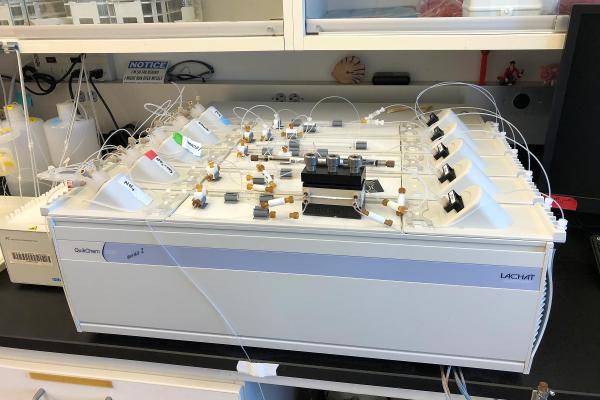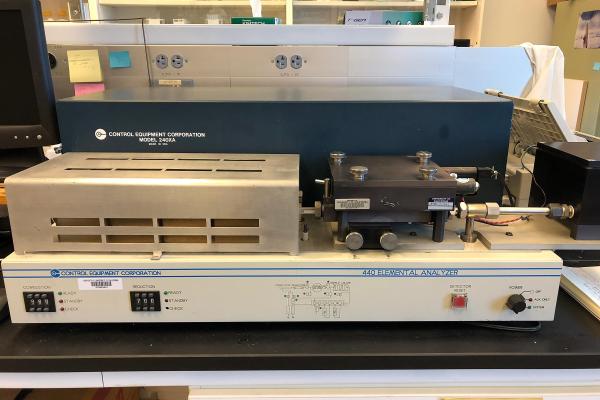Flow Injection Analysis — Nutrients

- Manufacturer: Seal Analytical
- Model: SEAL AA500 AutoAnalyzer
- Capabilities
- Simultaneous determination of up to 5 analytes per sample
- Random-access autosampler with racks for up to 120 samples per batch
- Analytical manifolds available:
- Nitrite
- Nitrate plus Nitrite
- ortho-Phosphate
- Silicic Acid
- Ammonium
General Description
Flow injection analysis (FIA) is a continuous-flow technique for automated wet-chemical analysis. The methodology used by the flow injection analyzer is similar to that used by AutoAnalyzers, with continuously flowing reagent streams, reaction 'manifolds', and flow-through detectors. However, FIA does not use air-bubble segmentation to separate samples and promote mixing. Instead, small diameter tubing is used in the manifolds, resulting in laminar flow conditions in which mixing takes place by axial and radial diffusion, and the manifolds are self-cleaning. Diffusion (dilution and mixing) is controlled by manifold design. A major practical advantage of this technology over that of air-segmentation, is that analytical results are usually available within a minute or so from the time the sample is aspirated, so any problems in the system can be spotted quickly and corrected, with little wasted time. The overall analysis times also tend to be shorter with FIA, so more samples can typically be analyzed in a given period of time. Precision and detection limits are generally comparable between the two technologies.
The software that controls our instrument is Windows 10 based, and displays real-time graphical output of any or all of the active detectors. This is extremely useful for during-run monitoring of the instrument's performance. Data is stored on disk, and is available for post-run processing in a variety of formats. The software also provides a wide range of quality control options to ensure accurate and reliable results. These include check-standards, control samples, same-vial or different-vial replicates, and spikes.
Elemental Analyzers — CHN

- Manufacturer: Control Equipment Corp. (now Exeter Analytical)
- Model: CEC 440HA (2 units)
- Features
- High-temperature combustion analysis
- Simultaneous determination C, H, and N as weight percents
- Horizontal combustion tube with removal of spent sample capsules
- Autosampler tray (64 sample positions) sealed under helium during run
General Description
Our instruments determine organic carbon, hydrogen, and nitrogen by means of high-temperature (1000C) combustion (Dumas method) of microgram to milligram size samples in an oxygen-enriched helium atmosphere. The combustion products CO2, NOX (reduced to N2), and H2O are separated by means of sequential, selective chemical traps, and measured with three pairs of high-precision thermal conductivity detectors. Interfering gases of sulfur, halogens, and phosphorus are removed in the combustion reactor using the appropriate solid reagents. Samples, which have been precisely weighed into small tin capsules, placed in protective nickel sleeves, and loaded into the autosampler wheel, are introduced into the combustion furnace by means of a mechanically operated quartz ladle. When combustion is complete, the ladle is withdrawn, and the sample and capsule residue in the nickel sleeve is deposited in a waste chamber (also sealed under helium during the run), thus avoiding buildup of sample residue in the combustion tube. Analysis results are reported in weight percent of the element.
In addition to solid sample materials, particulate organic matter trapped on glass fiber filters can be analyzed. Filters are not weighed, but are placed directly into nickel sleeves for analysis. (A nickel sleeve can accommodate a filter of up to 25mm diameter.) Results are reported in absolute micrograms of the element on the filter.
The control software for the instruments is capable of having the autosampler deposit two sample capsules on the ladle for a single analysis. In this mode, called 'double-drop,' larger total sample weights (for low organic-content materials) and larger diameter glass fiber filters (up to 47mm) can be analyzed.
All instruments are tested regularly with certified reference materials and control standards for precision and accuracy.